The OnePlus One Review
by Joshua Ho on November 19, 2014 8:00 AM EST- Posted in
- Smartphones
- Android
- Mobile
- OnePlus
Battery Life
At this point, battery life is one of the number one priorities for a phone. While in 2013 our primary tests consisted of the web browsing test and video playback tests, we've expanded our suite to include Basemark OS II and GFXBench to simulate intensive general usage and gaming, respectively. For all of our tests in which the display is on, we calibrate the brightness of full white to be 200 nits in order to standardize and attempt to control for extraneous variables as much as possible. While this may seem arbitrary, it's important to do so to draw real conclusions about which phone has better battery life. 200 nits on a phone can be as low as 50% and as high as 90%, so setting a standardized brightness percentage would not be an effective method of controlling for display brightness. With that in mind, let's get to the battery life tests.

Here, we see that the OnePlus One takes the number three spot for battery life amongst phones and phablets. This is definitely a great result to start with, and is a solid 20% higher than the One (M8). However, the Huawei Ascend Mate 2 continues to hold its position with a long lead over just about anything else available in the market today.
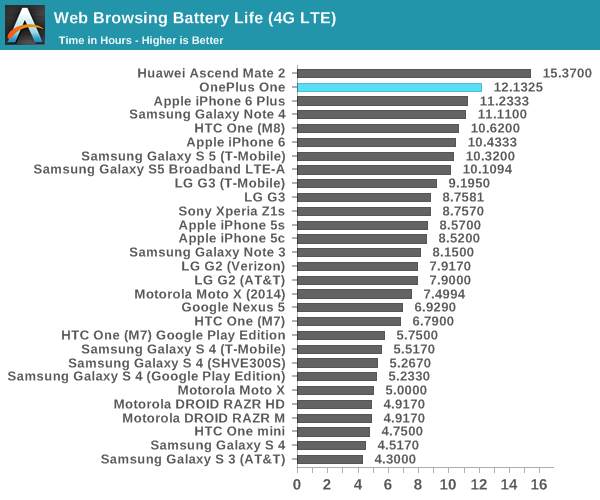
We can see a similar story in LTE web browsing battery life. However, the OnePlus One manages to close up the lead that the Ascend Mate 2 holds in WiFi browsing. It's likely that the 28nm LP process and lack of envelope tracker is responsible for closing the gap in this regard. It's interesting to see how the iPhone 6 Plus trails behind the OnePlus One here, but it's likely that this difference is due to the fact that the iPhone 6 Plus has an off-die modem compared to the OnePlus One's on-die modem.
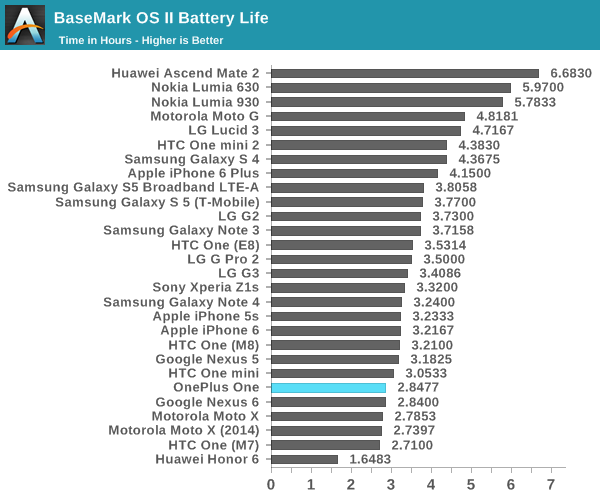

White battery life tends to fall towards the bottom here, we can see that the reality is that the OnePlus One performs quite well, which indicates that there's relatively little throttling to speak of and that the OnePlus One is simply doing well by sustaining high levels of performance.
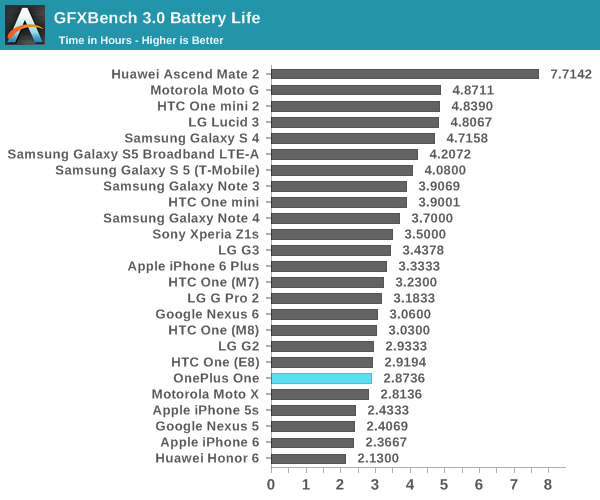
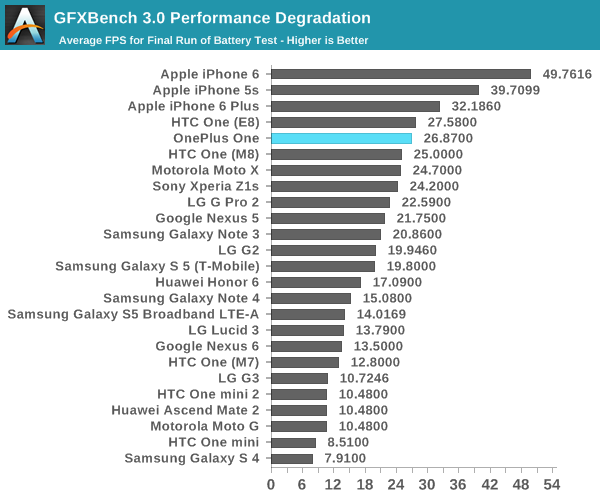
We see the same story in the GFXBench rundown. The OnePlus One manages to set a new record for final run FPS among phones and phablets, although battery life is near the bottom of the pack. It seems that if there's any one reason for the escalating display size wars, it is to increase battery life. While by no means a clear order, we can see that the larger battery more than compensates for the larger display of the OnePlus One. This makes sense, as a phone should have a fixed size circuit board. Therefore, by increasing display size the circuit boards become smaller relative to the rest of the phone, and all of the area opened up by increasing the size of the phone can be taken up by the battery. Overall, the OnePlus One is almost as good as it gets for battery life in a phone, with excellent sustained performance under load.
Charge Time
To really have a holistic understanding of battery life, we must also take a look at charge time. While battery life can be the only determinant of mobility, in cases where usage is heavy enough that the battery or multiple batteries have to be charged, charge time can become incredibly important. To this end, OnePlus includes a 5V, 2.1A charger in the box to quickly charge the rather large 11.78 WHr battery.
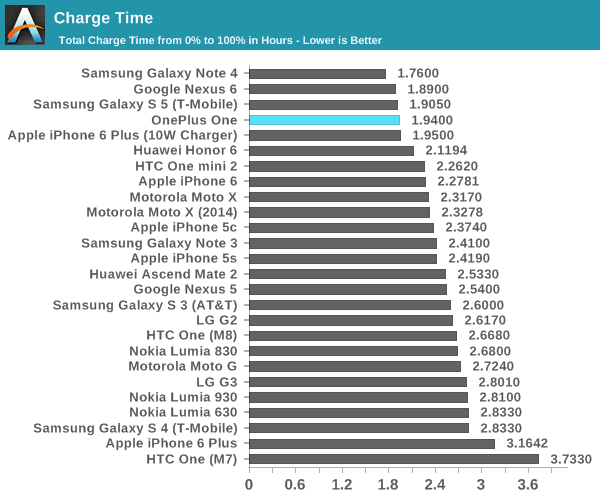
Somewhat surprisingly, the OnePlus One does a great job in this test, coming quite close to other devices with QC 2.0 fast chargers like the Galaxy Note 4 which is definitely good to see. Overall, this makes the OnePlus One one of the best phablets on the market for battery life.










148 Comments
View All Comments
tipoo - Wednesday, November 19, 2014 - link
That last part wouldn't make sense either, the M8 and 6 Plus have longer battery life during the test too.tipoo - Wednesday, November 19, 2014 - link
Oh yeah, and I'm pleasantly surprised this phone is getting a review at all, having much less mass consumer knowledge than some others despite a strong enthusiast following (yay, us!).JoshHo - Wednesday, November 19, 2014 - link
Compared to S801 devices the OnePlus One throttles relatively little.tipoo - Wednesday, November 19, 2014 - link
Ah, thanks for explaining. Any idea why this is? Just a big chassis, or the heat spreader on it, or software?jjj - Wednesday, November 19, 2014 - link
You need to at least specify what NAND the iphone you tested are using,All the iphone 6 and 6 plus numbers are compromised by Apple's usage of both MLC and TLC. You got major NAND perf and RAM usage differences and that should impact pretty much all the numbers.
ziangc - Wednesday, November 19, 2014 - link
thanks for the review :) that mentioned, would a comparison with the Oppo Find 7 yield a similar review conclusion? being a user of the Find 7, i would be interested to hear your 2 cents' worth on it as well.jjj - Wednesday, November 19, 2014 - link
"the first to kill the concept of a 650 USD"Hilariously how little you know and understand the market.
tipoo - Wednesday, November 19, 2014 - link
Go on? If you're thinking subsidized prices, you're still paying for that one way or another. The cost of the phone is included in the bill. Besides that, most carriers will take some percent off your bill if you bring your own phone. And besides *that*, some carriers just have plain crappy phones.tipoo - Wednesday, November 19, 2014 - link
Also for someone like me, I like having a smartphone, but since I'm in a wifi zone for so much of my life I don't bother paying for data. Bill is so much cheaper.Flunk - Wednesday, November 19, 2014 - link
That's funny, I thought I bought a Nexus 5 for $350 without carrier of any kind last year.